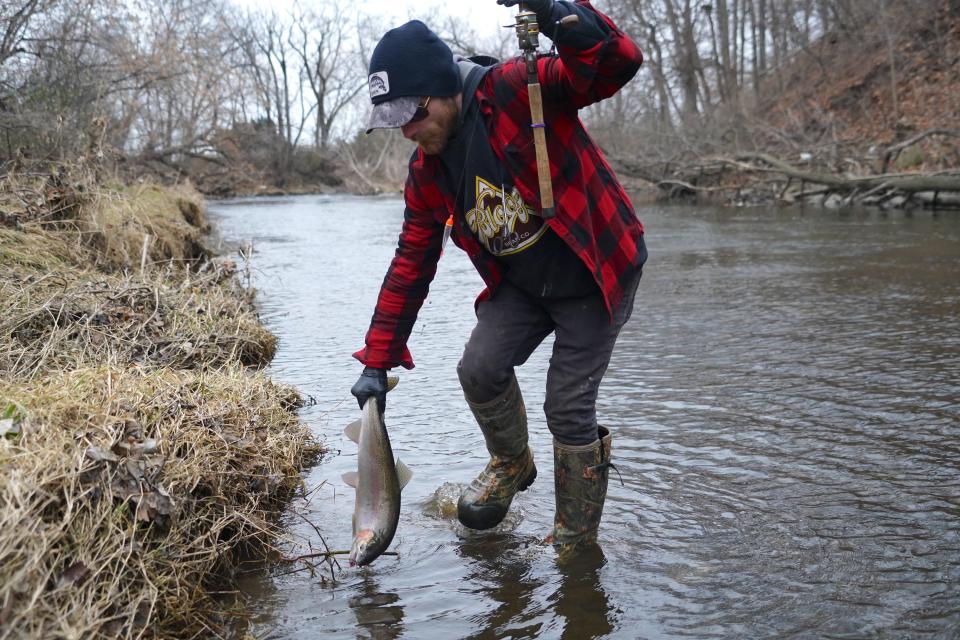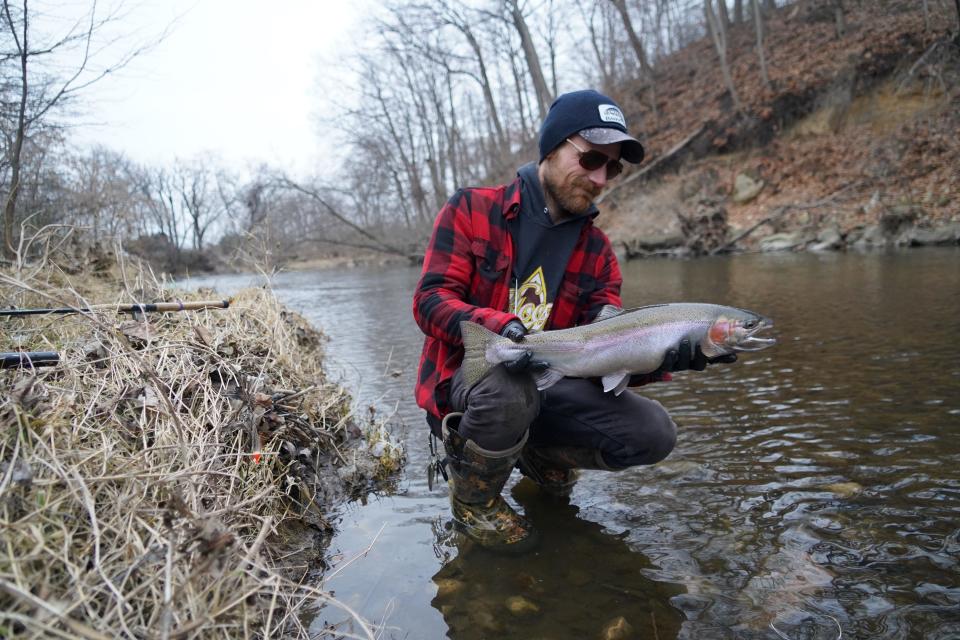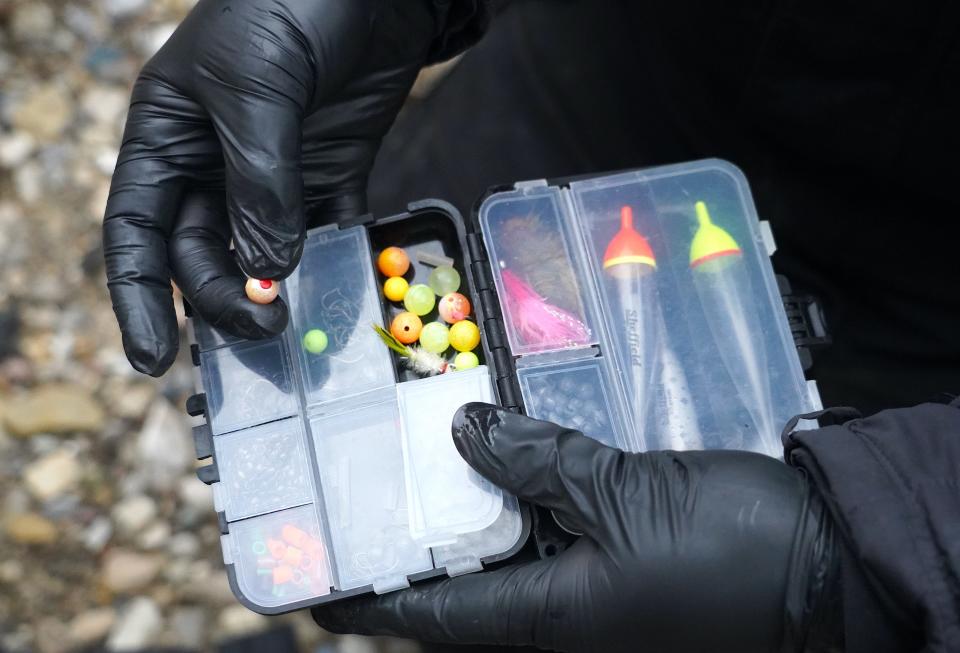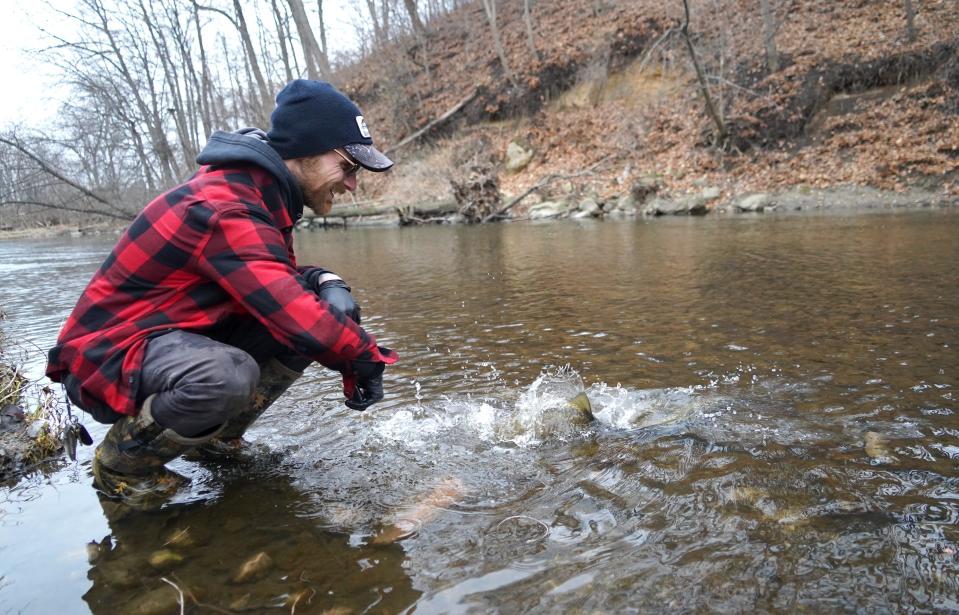Smith: Steelhead add a winter shine to Milwaukee's rivers

WAUWATOSA - A southeast wind whistles down the Menomonee River valley faster than any of the trains on the nearby track and deepens the chill on this damp, 38-degree December day.
The lack of sun doesn't make it any more comfortable. Even at noon, the woolly cloud deck creates a dimness that makes you question el sol's existence.
Pat Kiehm, 33, of Milwaukee is undaunted.
The experienced angler knows even in deep, dark December there is a brightness to be found in Wisconsin's Lake Michigan tributaries.
It comes in the form of steelhead, or rainbow trout. The fish travel from the Big Pond into streams such as the Menomonee on annual spawning migrations.
"This is my obsession," Kiehm said, rigging a 13-foot and then a 9-foot rod. "I've got respect for all fish, but for me the steelhead is the ultimate."
Kiehm and I joined recently to test several spots on the Menomonee in Wauwatosa. They ranged from city and county parks where the river's tree-lined shoulders looked wild and belied their urban setting to concrete canyons festooned with graffiti.
As far as we know, the steelhead pay attention only to the underwater features, however. They hold in areas with the right amount of depth and current and cover regardless of the street address.
Kiehm has spent years learning the best steelhead spots in southeastern Wisconsin rivers, but especially the Milwaukee and Menomonee.
The timing of our outing is fortuitous. Rivers can be too high to fish, or so low it makes things more difficult. The Menomonee today has a "Goldilocks" flow: just right.
Our first stop is in a wild-looking stretch 200 yards south of the railroad tracks and State Street. Here the river is 40-feet wide and forms a riffle and run that drops to about 4 feet in depth.
The north edge has a sand and gravel bar topped with dormant canary grass. The current on the opposite side cuts into the bank and carries more water. Maples and willows form walls on two sides and a knoll rises to the south.
To a steelheader, there's no doubt where the fish will be holding.
"I like how that pocket is dark and sexy looking," Kiehm says, nodding at a piece of water toward the top of the run.
The first drift with a spawn sac under a float on the 9-foot rod is all it takes for proof. The rig tumbles downriver for 10 feet, then the bobber sags beneath the surface and Kiehm rips a hookset.
The river lights up with a chrome and pink fish on the end of the line.

"This is my adrenaline rush," Kiehm says as he leverages the long rod against the lively steelhead.
After several minutes of to-and-fro he works the fish to the shallows, tails it and removes the hook with a forceps. The fish is about 5 pounds in weight and 25 inches long. It is, in steelheader's parlance, a "chromer," or a bright fish that recently migrated into the river.
Kiehm then kneels briefly and admires the steelhead at the river's edge before releasing it. The fish splashes us a good-bye.
"It doesn't get much more flawless than that," Kiehm says.
Steelhead were the first species stocked in Wisconsin waters of Lake Michigan program
Steelhead were the pioneers of Wisconsin's Lake Michigan salmon and trout stocking program.
After the Big Pond's native top predator fish, lake trout and burbot, were laid low in the middle 20th Century by overfishing by commercial interests and parasitism by the invasive sea lamprey, the lake swelled with nuisance numbers of alewife, another invasive aquatic species.
Beaches around the lake were coated with stinking windrows of the dead, silvery fish.
Some forward-thinking natural resources managers decided to try to use the abundance of forage to build a new fishery.
They turned to Pacific Ocean species of salmon and trout. What started as an experiment - it would require fish that in their native range spend most of their lives in salt water to instead do so in fresh - became a smashing success.
Steelhead were the first species stocked in the Wisconsin waters of Lake Michigan as part of the new program, according to Department of Natural Resources data. It started with 9,000 steelhead in 1963, followed by 15,000 in 1964. In 1965 lake trout were added, too.
Sixty years after those first steelhead were planted the Lake Michigan fishery is world famous and features chinook salmon, coho salmon and steelhead (all of Pacific Ocean origins) as well as brown trout (Europe) and native lake trout, brook trout and burbot. All species are stocked except for burbot.

Steelhead have been a constant in the DNR's Lake Michigan salmon and trout program since that first year.
The agency stocks several strains of steelhead, including Arlee, Chambers Creek, Ganaraska and Skamania. The names correspond to rivers or areas in the strains' native range in the Pacific Northwest.
Many positives in choice of steelheads for Wisconsin stocking program
The fish present several advantages to fisheries managers and anglers.
First, steelhead have a varied diet, including invertebrates such as insects as well as bait fish. It's not uncommon for anglers to catch steelhead on lures trolled near the surface on the Big Pond.
The diversity in steelhead food choices puts less strain on the lake's alewife population, which is the preferred forage for chinook salmon, the most stocked and fastest growing species in the lake, and makes steelhead more likely to survive potential downturns in prey fish numbers.
Second, unlike salmon which reach maturity and die after spawning, steelhead can live to spawn multiple times.
Third, steelhead can be found in tributaries for most months of the year, typically from September to May, including the bitterest days of winter.
Fourth, over the decades steelhead have shown the ability to reproduce naturally, mostly in streams on the Michigan side of Lake Michigan. So a portion of the Big Pond's fishery is "wild" and self-perpetuating.
Steelhead stocking in the Wisconsin waters of Lake Michigan was 439,203 yearlings in 2021 and was bumped up to 1,001,269 (a mix of yearlings and fingerlings) in 2022 to offset chinook and coho shortfalls in spring 2022, according to the DNR.
The 2022 steelhead stocking included Chambers Creek, Ganaraska, Skamania and Little Manistee River (from Michigan) strain fish.
All of that is good news for tributary anglers such as Kiehm.
We hit three other spots on the Menomonee over the next four hours and had multiple bites at each. Not all fish were landed but those that did were "dimes." One recently stocked 6-inch-long brook trout also came to hand and was released.

A spawn sac or a bead, both fished beneath a float, accounted for all the fish.
At 4 p.m. the conditions are so dark a headlamp is more than a little handy to tie a knot or select a bead.
We call it a day about sunset. At least that's what the clock says.
The light and energy this afternoon has come from the introduced fish that wears a pink stripe and graces our rivers for many months each year.
Kiehm, who likely spends more days each year pursuing steelhead on local waters than any other angler through personal outings and trips with clients through PK Fishing Tours, his part-time guiding business, will keep at it.
The Wisconsin fishing season for trout and salmon is open 365 days a year below the first dam of Lake Michigan rivers.

When the rivers turn solid, he shifts to spots he can target steelhead through the ice.
"(Steelhead) are here now and more are coming," Kiehm says as we hike up the Menomonee's bank one last time. "That's all it takes for me to look forward to 2023."
Smith:New technology shows how a wolf followed the old path that led to the species' recovery in Wisconsin
Our subscribers make this reporting possible. Please consider supporting local journalism by subscribing to the Journal Sentinel at jsonline.com/deal.
DOWNLOAD THE APP: Get the latest news, sports and more
This article originally appeared on Milwaukee Journal Sentinel: Steelhead, rainbow trout add a winter shine to Milwaukee's rivers


